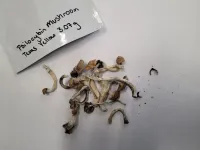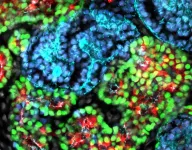(Press-News.org) A five-day course of once-daily inorganic nitrate reduces the risk of a serious complication following a coronary angiogram, in which the dye used causes damage to the kidneys. The clinical trial, led by Queen Mary University of London and funded by Heart Research UK, also showed that the five-day course improves renal outcomes at three months and major adverse cardiac events (MACE) at one year compared to placebo.
Contrast-induced nephropathy (CIN), also known as contrast associated acute kidney injury (CA-AKI), is an uncommon but serious complication following coronary angiography. Coronary angiography is a commonly used procedure that allows healthcare professionals to examine the blood supply to the heart. A special dye, which is visible on x-rays, is injected into the body and when the dye reaches the coronary arteries, an x-ray is taken. While coronary angiography is safe for most people, some patients are at high-risk of CIN, which is a significant cause of death and critical illness for high-risk patients who have had coronary angiographic procedures. For older people and those with heart failure, chronic kidney disease (CKD) or diabetes with CKD, incidence of CIN can be as high as 55%. CIN can lead to serious consequences for patients - including longer hospital stays, increased need for kidney transplants, recurrent revascularisation procedures, and higher mortality.
One of the principal mechanisms underlying CIN is thought to be an increase of oxidative stress and the accompanying decrease in levels of protective nitric oxide (NO) in the body. This randomised controlled trial, led by Professor Amrita Ahluwalia at Queen Mary University of London and funded by Heart Research UK, examined whether ingesting inorganic nitrate (NO3-) which becomes nitrite (NO2-) and then NO in the body – could compensate for the loss of NO in the body and help prevent kidney injury in high-risk patients receiving contrast angiography.
640 patients undergoing angiography for non-ST-elevation Acute Coronary Syndrome (ACS) (NSTE-ACS) at Barts Health NHS Trust took part in the trial, with 319 receiving once daily inorganic nitrate capsules (potassium nitrate) and 321 receiving a placebo capsule (potassium chloride). The study showed that patients receiving inorganic nitrate treatment had significantly reduced CIN rates (9.1%) vs placebo (30.5%), lower rates of procedural myocardial infarction (2.7% vs 12.5%), improved three-month renal function and reduced one-year major adverse cardiac events (MACE) (9.1% vs 18.1%) compared to patients who had received the placebo treatment. These findings together support the concept of NO replacement in the form of a short five –day simple inorganic nitrate capsule as a potential solution to prevent CIN and improve both cardiovascular and kidney outcomes after ACS.
Professor Amrita Ahluwalia, Dean for Research, Faculty of Medicine and Dentistry at Queen Mary, said: “The current gold-standard treatment for blocked coronary arteries is inserting a stent. To do this the cardiologist needs to be able to see where the artery is blocked and that is why it is necessary to use a dye to allow the artery to be clearly seen on the angiogram. This trial suggests that a simple 5-day regime of low-cost inorganic nitrate capsule eliminates the risk of what were, up till now, unavoidable damaging effects. We hope to confirm these findings in a large multi-centre trial in the near future, but the results of Nitrate-CIN give us hope.”
Kate Bratt-Farrar, Chief Executive at Heart Research UK, said: “We are pleased to fund this research led by Professor Ahluwalia, which hopes to make changes to coronary angiogram protocols and reduce the risk of serious complications for patients. This will allow healthcare professionals to conduct safer treatments and improve patient wellbeing for those at high-risk of developing complications.
“It is amazing to see the positive outcome of this breakthrough in cardiac research, which was funded by our Translational Research Programme of grants, aiming to bridge the gap between laboratory-based scientific research and patient care. This study has the potential to save countless lives across the UK.”
Approximately 250,000 coronary angiograms are carried out in the UK every year. Contrast-induced nephropathy (CIN) is deemed responsible for a third of all hospital-acquired acute kidney injuries. Recent assessments of the occurrence of this complication globally suggest an incidence of 12.8% with an associated mortality in those experiencing CIN of 20.2%.
ENDS
NOTES TO EDITORS
Contact:
Honey Lucas
Faculty Communications Officer – Medicine and Dentistry
Queen Mary University of London
Email: h.lucas@qmul.ac.uk or press@qmul.ac.uk
Paper details:
Amrita Ahluwalia, et al. “Inorganic nitrate benefits contrast-induced nephropathy after coronary angiography for acute coronary syndromes: the NITRATE-CIN Trial.” Published in European Heart Journal.
DOI: 10.1093/eurheartj/ehae100
Available after publication at: https://academic.oup.com/eurheartj/article-lookup/doi/10.1093/eurheartj/ehae100
Under strict embargo until 1am GMT on Tuesday 19 March 2024.
A copy of the paper is available upon request.
Funding information: Heart Research UK.
Conflicts of Interest Disclosures: Professor Ahluwalia is a Director of HeartBeet Ltd.
About Queen Mary
www.qmul.ac.uk
At Queen Mary University of London, we believe that a diversity of ideas helps us achieve the previously unthinkable.
Throughout our history, we’ve fostered social justice and improved lives through academic excellence. And we continue to live and breathe this spirit today, not because it’s simply ‘the right thing to do’ but for what it helps us achieve and the intellectual brilliance it delivers.
Our reformer heritage informs our conviction that great ideas can and should come from anywhere. It’s an approach that has brought results across the globe, from the communities of east London to the favelas of Rio de Janeiro.
We continue to embrace diversity of thought and opinion in everything we do, in the belief that when views collide, disciplines interact, and perspectives intersect, truly original thought takes form.
About Heart Research UK
Proud to stand out from the crowd, Heart Research UK is the charity dedicated to your heart. They’re confronting heart diseases by investing in pioneering medical research, ground-breaking training and education, and in communities to improve their heart health for themselves. For over 50 years they have driven advancements in the prevention, treatment and cure of heart disease to benefit patients as soon as possible.
In the last 10 years, Heart Research UK has funded over £14.8m in medical research in hospitals and universities across the UK, as well as £1.3m on innovative community-based lifestyle projects to improve the heart health of the nation.
They won’t stop until there are no more deaths from heart diseases.
If you’d like to support Heart Research UK’s vital work into the prevention, treatment and cure of heart disease, please visit www.heartresearch.org.uk for inspiration on how you could help.
END
Inorganic nitrate can help protect patients against kidney damage caused during coronary angiographic procedures
2024-03-19
ELSE PRESS RELEASES FROM THIS DATE:
Active social lives help dementia patients, caregivers thrive
2024-03-19
EMBARGOED FOR RELEASE
6 p.m. PT / 9 p.m. ET, March 18, 2024
To coincide with publication in The Gerontologist
Media Contact: Suzanne Leigh (415) 680-5133
Suzanne.Leigh@UCSF.edu
Subscribe to UCSF News
People with dementia and those who care for them should be screened for loneliness, so providers can find ways to keep them socially connected, according to experts at UC San Francisco and Harvard, who made the recommendations after finding that both groups experienced declines in social well-being as the disease progressed.
The patients, whose ...
New technique measures psilocybin potency of mushrooms
2024-03-19
Since the 1970s, the federal government has listed the active ingredients in mushrooms—psilocybin and psilocin—as illegal and having no accepted medical use.
However, in recent years, medical professionals have found that these substances are safe and effective for treating stubborn conditions such as treatment-resistant depression and post-traumatic stress disorder. Some jurisdictions now allow for the medical use of mushrooms, while others are considering permitting or at least decriminalizing their recreational use.
Clinicians now find themselves needing to carefully ...
UC Irvine-led research team discovers role of key enzymes that drive cancer mutations
2024-03-19
Irvine, Calif., March 18, 2024 — A research team led by the University of California, Irvine has discovered the key role that the APOBEC3A and APOBEC3B enzymes play in driving cancer mutations by modifying the DNA in tumor genomes, offering potential new targets for intervention strategies.
The study, published today online in the journal Nature Communications, describes how the researchers identified the process by which APOBEC3A and APOBEC3B detect specific DNA structures, resulting in mutations at distinct positions within the tumor genome.
“It’s critical to understand how cancer cells accumulate mutations leading to ...
All creatures great and small: Sequencing the blue whale and Etruscan shrew genomes
2024-03-18
The blue whale genome was published in the journal Molecular Biology and Evolution, and the Etruscan shrew genome was published in the journal Scientific Data.
Research models using animal cell cultures can help navigate big biological questions, but these tools are only useful when following the right map.
“The genome is a blueprint of an organism,” says Yury Bukhman, first author of the published research and a computational biologist in the Ron Stewart Computational Group at the Morgridge Institute, an independent research organization that works in affiliation with the University of Wisconsin–Madison in emerging fields ...
Sustainable solution for wastewater polluted by dyes used in many industries
2024-03-18
Water pollution from dyes used in textile, food, cosmetic and other manufacturing is a major ecological concern with industry and scientists seeking biocompatible and more sustainable alternatives to protect the environment.
A new study led by Flinders University has discovered a novel way to degrade and potentially remove toxic organic chemicals including azo dyes from wastewater, using a chemical photocatalysis process powered by ultraviolet light.
Professor Gunther Andersson, from the Flinders Institute for NanoScale Science and Technology, says the process involves creating metallic ‘clusters’ of just nine gold (Au) atoms chemically ‘anchored’ ...
Food companies’ sponsorship of children’s sports encourages children to buy their products, Canadian research suggests
2024-03-18
*This is an early press release from the European Congress on Obesity (ECO 2024) Venice 12-15 May. Please credit the Congress if using this material*
Food companies’ sponsorship of children’s sports may encourage children to buy their products, new research to be presented at the European Congress on Obesity (ECO 2024) (Venice 12-15 May), has found.
The Canadian research also found that many children view food companies that sponsor or give money to children’s sports as being “generous” ...
USC receives $3.95 million CIRM grant for organoid resource center
2024-03-18
To democratize access to lab-grown organ-like structures known as organoids and other advanced stem cell and transcriptomic technologies, USC will launch the CIRM ASCEND Center, dedicated to “Advancing Stem Cell Education and Novel Discoveries.” Funded by a $3.95 million grant from the California Institute for Regenerative Medicine (CIRM), the voter-created state agency charged with distributing public funding to support stem cell research and education, ASCEND joins a network of shared resources laboratories ...
New research finds boreal arctic wetlands are producing more methane over time
2024-03-18
MADISON –– Scientists have been measuring global methane emissions for decades, but the boreal arctic —with a wide range of biomes including wetlands that extend across the northern parts of North America, Europe and Asia — is a key region where accurately estimating highly potent greenhouse gas emissions has been challenging.
Wetlands are great at storing carbon, but as global temperatures increase, they are warming up. That causes the carbon they store to be released into the atmosphere in the form of methane, which contributes to more global warming.
Now, researchers — including the University ...
TLI Investigator Dr. Wei Yan named Editor-in-Chief of the Andrology Journal
2024-03-18
The Lundquist Institute is proud to announce that Wei Yan, MD, PhD, a distinguished professor at the David Geffen School of Medicine at UCLA and Lundquist investigator, has been appointed by the American Society of Andrology and the European Academy of Andrology as the new Editor-in-Chief of Andrology, the highly-respected journal in the field of reproductive medicine.
Dr. Yan's appointment to Andrology is a testament to his dedication to reproductive medicine. With extensive editorial experience, including his previous roles as ...
New study reveals insights into COVID-19 antibody response durability
2024-03-18
Researchers at the Institute of Human Virology (IHV) at the University of Maryland School of Medicine published a new study in the Journal of Infectious Diseases investigating the antibody response following SARS-CoV-2 infection.
Long-lived plasma cells are responsible for durable antibody responses that persist for decades after immunization or infection. For example, infection with measles, mumps, rubella, or immunization with vaccines against tetanus or diphtheria elicit antibody responses that can last for many decades. By contrast, other infections and vaccines elicit short-lived antibody responses that last only a few ...




